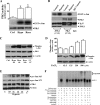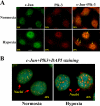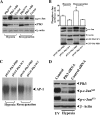Activation of Polo-like kinase 3 by hypoxic stresses
- PMID: 18650425
- PMCID: PMC2533803
- DOI: 10.1074/jbc.M801326200
Activation of Polo-like kinase 3 by hypoxic stresses
Abstract
Hypoxia/reoxygenation stress induces the activation of specific signaling proteins and activator protein 1 (AP-1) to regulate cell cycle regression and apoptosis. In the present study, we report that hypoxia/reoxygenation stress activates AP-1 by increasing c-Jun phosphorylation and DNA binding activity through activation of Polo-like-kinase 3 (Plk3) resulting in apoptosis. The specific effect of hypoxia/reoxygenation stress on Plk3 activation resulting in c-Jun phosphorylation was the opposite of UV irradiation-induced responses that are meanly independent on activation of the stress-induced JNK signaling pathway in human corneal epithelial (HCE) cells. The effect of hypoxia/reoxygenation stress-induced Plk3 activation on increased c-Jun phosphorylation and apoptosis was also mimicked by exposure of cells to CoCl(2). Hypoxia/reoxygenation activated Plk3 in HCE cells to directly phosphorylate c-Jun proteins at phosphorylation sites Ser-63 and Ser-73, and to increase DNA binding activity of c-Jun, detected by EMSA. Further evidence demonstrated that Plk3 and phospho-c-Jun were immunocolocalized in the nuclear compartment of hypoxia/reoxygenation stress-induced cells. Increased Plk3 activity by overexpression of wild-type and dominantly positive Plk3 enhanced the effect of hypoxia/reoxygenation on c-Jun phosphorylation and cell death. In contrast, knocking-down Plk3 mRNA suppressed hypoxia-induced c-Jun phosphorylation. Our results provide a new mechanism indicating that hypoxia/reoxygenation induces Plk3 activation instead of the JNK effect to directly phosphorylate and activate c-Jun, subsequently contributing to apoptosis in HCE cells.
Figures






Similar articles
-
Stress-induced c-Jun activation mediated by Polo-like kinase 3 in corneal epithelial cells.J Biol Chem. 2007 Nov 2;282(44):32121-7. doi: 10.1074/jbc.M702791200. Epub 2007 Sep 5. J Biol Chem. 2007. PMID: 17804415
-
Hyperosmotic stress-induced corneal epithelial cell death through activation of Polo-like kinase 3 and c-Jun.Invest Ophthalmol Vis Sci. 2011 May 16;52(6):3200-6. doi: 10.1167/iovs.10-6485. Invest Ophthalmol Vis Sci. 2011. PMID: 21296815 Free PMC article.
-
Effect of Hypoxia-regulated Polo-like Kinase 3 (Plk3) on Human Limbal Stem Cell Differentiation.J Biol Chem. 2016 Aug 5;291(32):16519-29. doi: 10.1074/jbc.M116.725747. Epub 2016 Jun 8. J Biol Chem. 2016. PMID: 27281822 Free PMC article.
-
Polo-like kinase 3, hypoxic responses, and tumorigenesis.Cell Cycle. 2017;16(21):2032-2036. doi: 10.1080/15384101.2017.1373224. Epub 2017 Sep 21. Cell Cycle. 2017. PMID: 28857653 Free PMC article. Review.
-
From JNK to pay dirt: jun kinases, their biochemistry, physiology and clinical importance.IUBMB Life. 2005 Apr-May;57(4-5):283-95. doi: 10.1080/15216540500097111. IUBMB Life. 2005. PMID: 16036612 Review.
Cited by
-
Design, synthesis and biological evaluation of 2H-benzo[b][1,4] oxazine derivatives as hypoxia targeted compounds for cancer therapeutics.Bioorg Med Chem Lett. 2009 Aug 1;19(15):4204-6. doi: 10.1016/j.bmcl.2009.05.110. Epub 2009 Jun 2. Bioorg Med Chem Lett. 2009. PMID: 19515559 Free PMC article.
-
Hyperosmotic stress-induced ATF-2 activation through Polo-like kinase 3 in human corneal epithelial cells.J Biol Chem. 2011 Jan 21;286(3):1951-8. doi: 10.1074/jbc.M110.166009. Epub 2010 Nov 22. J Biol Chem. 2011. PMID: 21098032 Free PMC article.
-
Roles of Polo-like kinase 3 in suppressing tumor angiogenesis.Exp Hematol Oncol. 2012 Apr 18;1(1):5. doi: 10.1186/2162-3619-1-5. Exp Hematol Oncol. 2012. PMID: 23210979 Free PMC article.
-
Multifaceted polo-like kinases: drug targets and antitargets for cancer therapy.Nat Rev Drug Discov. 2010 Aug;9(8):643-60. doi: 10.1038/nrd3184. Nat Rev Drug Discov. 2010. PMID: 20671765 Review.
-
Inhibition of PLK3 Attenuates Tubular Epithelial Cell Apoptosis after Renal Ischemia-Reperfusion Injury by Blocking the ATM/P53-Mediated DNA Damage Response.Oxid Med Cell Longev. 2022 Jun 24;2022:4201287. doi: 10.1155/2022/4201287. eCollection 2022. Oxid Med Cell Longev. 2022. PMID: 35783188 Free PMC article.
References
-
- Singh, N., Amin, S., Richter, E., Rashid, S., Scoglietti, V., Jani, P. D., Wang, J., Kaur, R., Ambati, J., Dong, Z., and Ambati, B. K. (2005) Investig. Ophthalmol. Vis. Sci. 46 1647–1652 - PubMed
-
- Singh, N., Jani, P. D., Suthar, T., Amin, S., and Ambati, B. K. (2006) Investig. Ophthalmol. Vis. Sci. 47 4787–4793 - PubMed
-
- Cursiefen, C., Maruyama, K., Jackson, D. G., Streilein, J. W., and Kruse, F. E. (2006) Cornea 25 443–447 - PubMed
-
- Mwaikambo, B. R., Sennlaub, F., Ong, H., Chemtob, S., and Hardy, P. (2006) Invest Ophthalmol. Vis. Sci. 47 4356–4364 - PubMed
-
- Zhang, M. C., Wang, Y., and Yang, Y. (2006) Ocul. Immunol. Inflamm. 14 359–365 - PubMed
Publication types
MeSH terms
Substances
Grants and funding
LinkOut - more resources
Full Text Sources
Molecular Biology Databases
Research Materials
Miscellaneous

